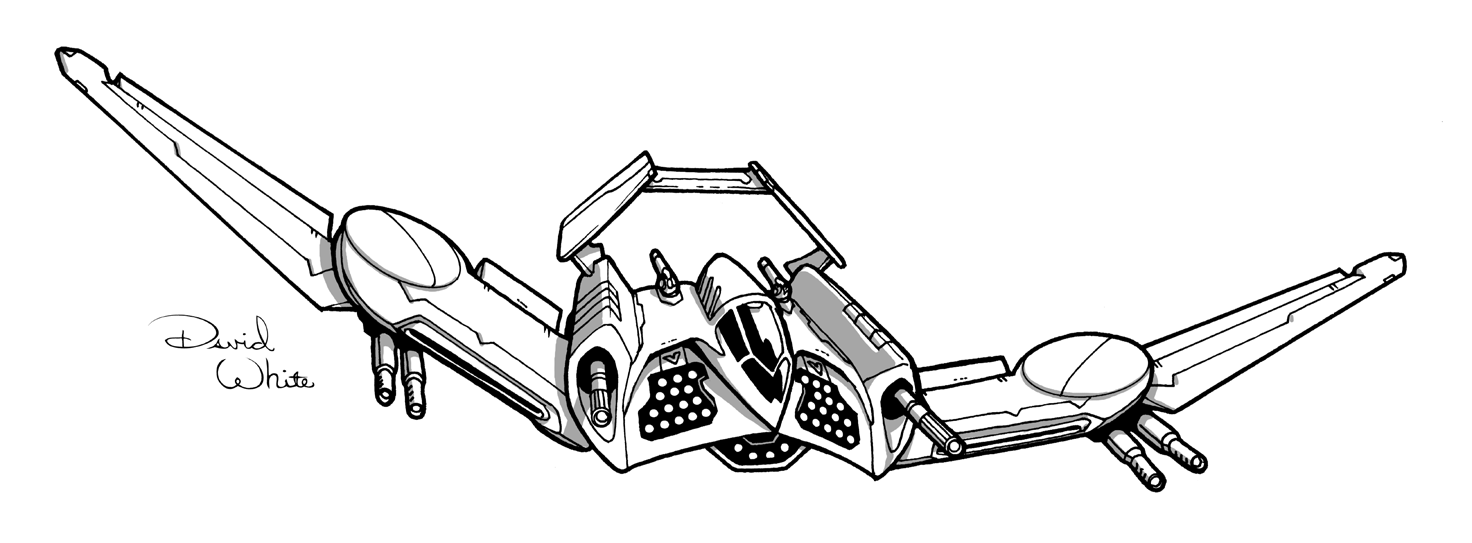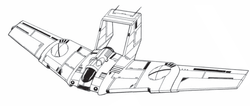Difference between revisions of "Chippewa"
m |
m (→Bibliography) |
||
| Line 68: | Line 68: | ||
[[Category:Heavy AeroSpace Fighters]] | [[Category:Heavy AeroSpace Fighters]] | ||
[[Category:SLDF 2750 AeroSpace Fighters]] | [[Category:SLDF 2750 AeroSpace Fighters]] | ||
| + | [[Category:SLDF Royal AeroSpace Fighters]] | ||
Revision as of 22:40, 1 October 2011

| |
| Chippewa | |
| Production information | |
| Manufacturer | Bowie Industries |
| Model | CHP-W5 |
| Class | Heavy |
| Tech Base | Inner Sphere |
| Cost | 5,410,530[1] |
| Technical specifications | |
| Mass | 90 tons |
| Structural Integrity | 9 |
| Frame | Bowie 50 |
| Power Plant | PlasmaStar 270 |
| Fuel | 400 - 5 tons |
| Armament |
|
| Communications System | Rander 200 |
| Tracking & Targeting System | Rander TA5 |
| Heat Sinks | 25 |
| BV (1.0) | 1180 |
| BV (2.0) | 1554[2] |
Description
Designed by the Star League, the heavy Chippewa isn't extremely fast, but it has an impressive array of armament. Mostly used in the Lyran Commonwealth, the Chippewa has become House Steiner's main heavy fighter. Prior to the start of the First Succession War Steiner captured the Bowie Industries plant on Dell, where W5 models were produced until House Kurita successfully destroyed the plant in a raid.
A heavy fighter, the Chippewa utilizes its large wings to provide added maneuverability when fighting in an atmosphere. The outer portions of each wing can retract inward, allowing for the fighter to be stored aboard transports more easily.
Armament
Short or long range, it is best to stay away from a Chippewa. With the Exostar LRM-15 and SRM-6 racks to the front, backed up by two Martell Medium Lasers in the nose and four McCorkel Large Lasers in the wings, the Chippewa can lay down a devastating first strike. For rear protection, two McCorkel Small Lasers are mounted to the rear. The Chippewa was the first SLDF fighter to mount specialized Laser Insulators, however the technological know-how to produce this insulation was lost during the Succession Wars and later models were built without them.
Variants
- CHP-W5B - This version of the Chippewa drops the SRM-6 and upgrades the Large Lasers to extended range models. It also adds Artemis IV to the LRM racks and carries twenty-five double heat sinks. BV (2.0) = 2,051[3]
- CHP-W7 - A House Steiner upgrade of the CHP-W5 using recovered technology, the CHP-W7 Chippewa features Double Heat Sinks, an XL Engine, Ferro-Aluminum armor, and all lasers upgraded to pulse lasers.[4] BV (1.0) = 1,487[5], BV (2.0) = ??
- CHP-W7T - Based on the W7 this variant change the large pulse lasers to a pair of Snub-Nose PPCs and a pair Plasma Rifles in the wings. The LRM launchers are upgraded with a Artemis IV system. BV (1.0) = 1,262[6]
- CHP-W8 - This variant changes the LRM and SRM launchers in the nose to an MML-7 with Artemis IV for better close combat. BV (1.0) = 1,484[7]
- CHP-W10 - House Davion modification, eliminating two of the Large Lasers for an extra 9.5 tons of armor. BV (1.0) = 1516[8], BV (2.0) = 1,820
- Chippewa IIC - The Chippewa IIC was developed and used by Clan Mongoose during the Golden Century. Keeping with the heavy-hitting role of the original Chippewa, the IIC mated an advanced Targeting Computer to four wing-mounted ER Large Lasers, twin nose mounted ER Medium Lasers, and a pair of ER Small Lasers that covered the aft arc. This firepower was supplemented by a Streak SRM-4 and a pair of Artemis IV-enhanced LRM-15 launchers mounted in the nose. CASE protected the craft against ammunition explosions, while twenty-five double heat sinks kept the fighter's heat low. BV (2.0) = 3,341[9]
Custom Variants
- CHP-X-P Chippewa Gladstone - The personal Chippewa of Michael Gladstone, a deserter from the Lyran Regulars, the Chippewa Gladstone can be found near the Rim Collection acting as an escort for various merchant DropShips and JumpShips. Modified to carry a pair of Extended LRM-15 launchers in the nose, Gladstone can engage enemy forces from much further out than they expect. The standard armor has been removed and replaced with Laser Reflective Armor, which means energy weapons are far less effective against the Chippewa. If an enemy does manage to close with Gladstone they'll receive a rude shock: Ten ER Medium Lasers and enough Double Heat Sinks to use them. In the technology-starved Periphery, the Chippewa Gladstone is one of the most effective and fearsome AeroSpace Fighters in service. BV (2.0) = 1,635[10]
References
- ↑ Record Sheets: 3039, p. 289
- ↑ Record Sheets: 3039, p. 289
- ↑ Record Sheets: Operation Klondike, p. 89
- ↑ Objective Raids, p. 78
- ↑ Record Sheets: 3039, p. 290
- ↑ Record Sheets: 3039, p. 291
- ↑ Record Sheets: 3039, p. 294
- ↑ Record Sheets: 3039, p. 288
- ↑ Era Digest: Golden Century, p. 36
- ↑ Experimental Technical Readout: Pirates, p. 13




